Qualcomm’s leading role in driving advanced wireless technologies into the 3GPP global 5G standards

I first wrote about the five Qualcomm wireless inventions that defined the 5G NR Release 15 foundation in 2016, and it was a time when 5G was only a vision. With the completion of Release 16 in 2020, I published another blog post that outlined the importance of Release 16 and the key Qualcomm technology inventions that can enable the expansion of 5G to new devices, spectrum, and industries.
Just last week, 3GPP declared the official completion of 5G NR Release 17 (stage 3 functional freeze, with ASN.1 targeted for June). So, to continue with the tradition, let me provide a closer look at the technology inventions in Release 17. I have distilled them into five key areas where Qualcomm played a key role driving technology into the standards.
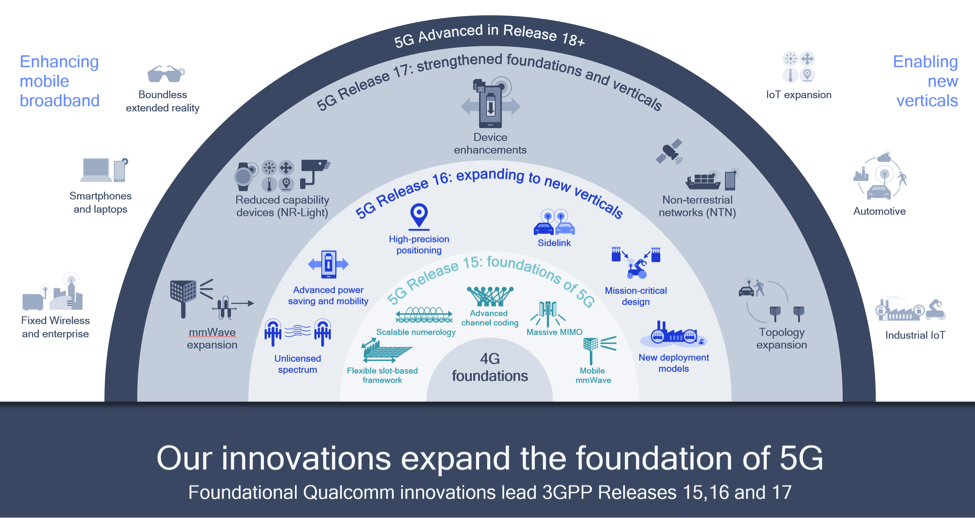
5G NR Release 17 — continued 5G expansion toward 5G Advanced
The completion of 3GPP Release 17 marked an important 5G milestone. Not only was it the third major release of the global 5G NR standard that continued the 5G expansion, but it also concluded the first phase of the 5G technology evolution across Releases 15, 16, and 17 ahead of 5G Advanced that starts in Release 18. Thanks to the perseverance of the 5G ecosystem, the completed package largely fulfilled the original vision that was set out for Release 17 in late 2019. Release 17 further expands the 5G technology foundations for coverage, mobility, power, reliability, etc. and broadens 5G’s reach to new use cases, deployments, and network topologies. Five key invention areas by Qualcomm are summarized below.
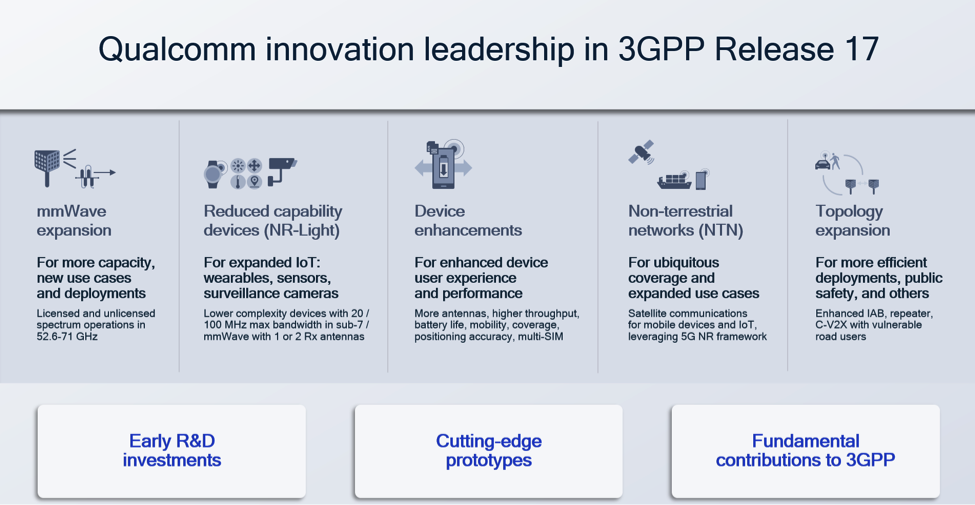
Invention area #1: Millimeter wave (mmWave) expansion
The first key Release 17 invention area is the expansion of mmWave frequency support, defining a new distinct frequency range called FR2-2 that goes from 52.6 GHz to 71 GHz. This is a long anticipated and important enhancement to 5G mmWave, as it makes the globally1 unlicensed 60 GHz band (57 to 71 GHz) available for 5G deployment, for both public and private networks. The mmWave expansion brings more network capacity and enables new use cases and deployments, such as mmWave private networks for smart manufacturing that support both communications and positioning. Thanks to the 5G NR scalable numerology and flexible slot-based framework, this frequency expansion directly scales the subcarrier spacing (SCS) for control and data channels to 480 and 960 kHz (previous 120 kHz for lower mmWave). In addition to frequency expansion, Release 17 also brings other mmWave enhancements, including expanded support for inter-band uplink/downlink carrier aggregation and improved mobility.

Invention area #2: 5G Reduced capability devices (NR-Light)
Our vision for 5G is an innovation platform that would evolve to connect virtually everyone and everything around us. 3GPP Release 17 continues to introduce new capabilities that will optimize the expansion to new devices, services, and deployments. To efficiently support lower complexity 5G devices, the 5G NR wideband design scales down to 5G NR-Light that supports 20 MHz and 100 MHz bandwidths for sub-7 GHz and mmWave, respectively. 5G NR-Light supports additional complexity reduction features, such as single Rx and half-duplex, as well as energy reduction techniques including lower transmit power and enhanced power saving modes. They allow efficient support for lower complexity devices such as wearables, industrial sensors, and surveillance cameras. The continued 5G NR-Light evolution in 5G Advanced (Release 18+) can further scale down device complexity for broader IoT support, bridging the gap between Release 17 5G NR-Light and eMTC/NB-IoT.
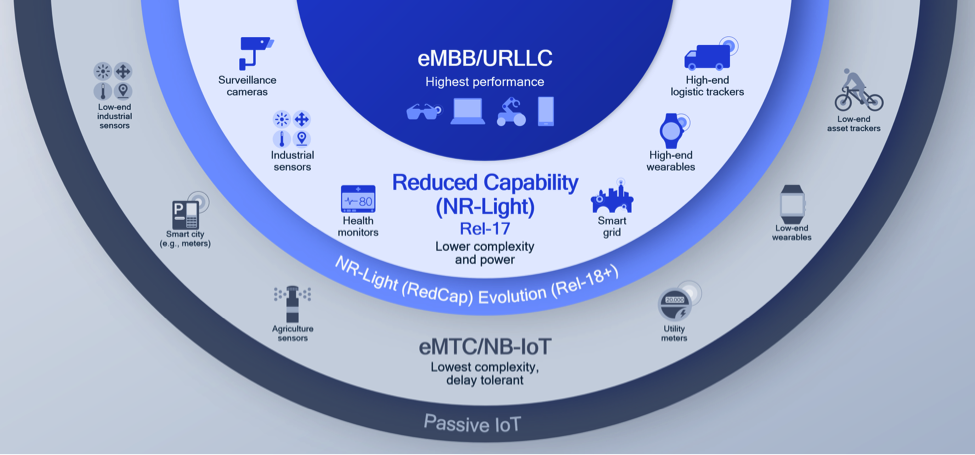
Invention area #3: Device enhancements
We continue to improve the end-to-end 5G system for better user experience, system efficiency, and performance. Release 17 specifications bring another wave of innovations to 5G devices, spanning across a wide range of new capabilities and enhancements. Some of the key new device features being introduced by Release 17 are:
- Support for up to eight antennas with additional layers that can deliver higher throughput
- Advanced MIMO enhancements that can improve capacity, throughput, and battery life
- New power saving features in both connected and idle modes that can extend battery life
- Dynamic repetitions and higher transmit power that can improve coverage for devices
- Enhanced 5G positioning that can improve positioning accuracy and latency
- Dual standby multi-SIM that can support concurrent operations of two subscriptions on a single network or on two networks
- And many others…
Invention area #4: Non-terrestrial networks (NTN)
For 5G to provide ubiquitous connectivity, it is imperative that it can also deliver network coverage in non-terrestrial areas, such as over the oceans and remote locations where terrestrial cellular networks do not exist. In Release 17, there are two parallel NTN workstreams that address mobile broadband and low-complexity IoT use cases. The first project adapts the 5G NR framework for satellite communications, enabling fixed wireless access (FWA) backhaul from the ground to the satellites as well as providing direct low-data rate and voice services for smartphones. The second project focused on supporting satellite access for low-complexity eMTC and NB-IoT devices, which expands the coverage for key use cases such as worldwide asset tracking (e.g., containers over the ocean or other devices outside of cellular coverage). Satellite communications will continue to evolve in 5G Advanced, and they are already part of the workplan for 3GPP Release 18.
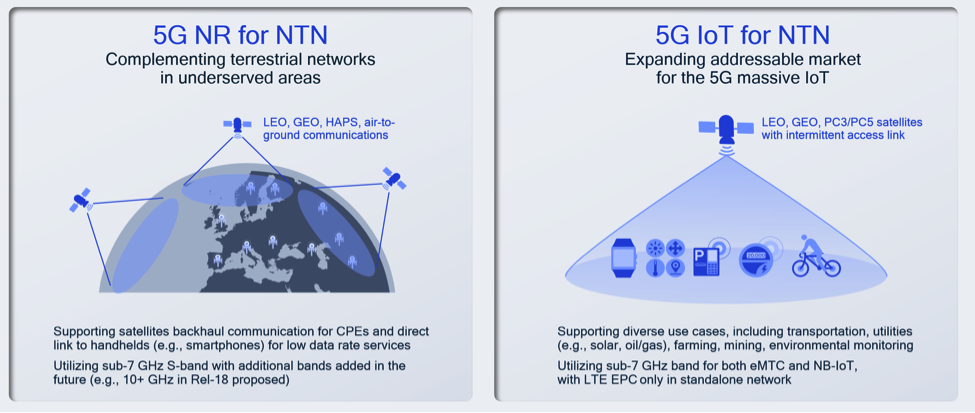
Invention area #5: Topology expansion
The last group of Release 17 innovations is the continued expansion of 5G topologies that bring enhanced system capabilities and new types of deployments. For integrated access and backhaul (IAB), features like simultaneous transmission/reception (i.e., full duplex) and enhanced multi-hop operations can further improve deployment efficiency, coverage, and performance. A new project on repeaters, especially useful for mmWave deployments, can more cost-efficiently and rapidly expand the coverage areas. They also set up for the continued evolution in 5G Advanced Release 18, which includes the support of mobile IAB/vehicle mounted relay and network-controlled (aka smart) repeaters. Additional enhancements are also made to C-V2X to support reliable communications with vulnerable road users, such as cyclists and pedestrians, to provide new level of automotive and public safety.

What’s next?
While 3GPP Release 17 is now complete, our work driving the 5G Advanced evolution is just starting. We are already working with the mobile ecosystem on a long list of Release 18 projects, and researching key technology areas for 5G Advanced and beyond. I am very excited about the future of wireless communications, and our early vision for 6G is already forming. There is a vast number of wireless innovations in the pipeline, and I am confident that they will fuel the breakthroughs in this decade and beyond.
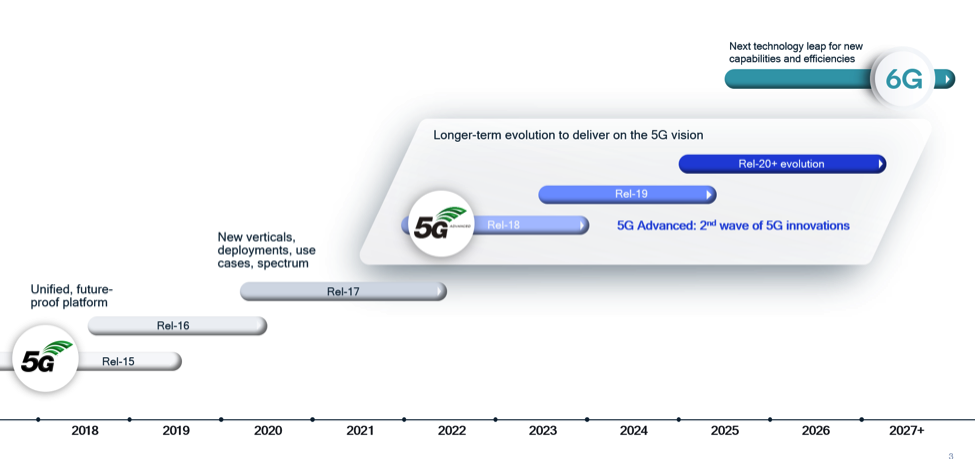
Learn more…
For a closer look at the completed projects in 3GPP Release 17, check out this blog post and visit our 5G technology website. Also, be sure to sign up for our wireless technologies newsletter to stay up to date as we accelerate into our 5G future.
1.) With some variations across countries/regions.

John Smee is Senior VP of Engineering and Global Head of Wireless Research at Qualcomm. He oversees all 5G/6G and Wi-Fi R&D projects including systems design, standards contributions, and advanced radio, hardware, and software research testbeds and technology trials with industry partners. He joined Qualcomm in 2000, holds over 175 U.S. Patents, and has focused on the innovation and commercial launches of wireless communications across 5G NR, 4G LTE, 3G CDMA, and IEEE 802.11. John also leads Qualcomm’s companywide academic collaboration program across wireless, semiconductor, automotive, multimedia, security, and machine learning. He was chosen to participate in the National Academy of Engineering Frontiers of Engineering program, and is currently serving on the National Academy of Medicine Committee on Emerging Science, Technology, and Innovation. He received his Ph.D. in electrical engineering from Princeton University and also holds an M.A. from Princeton and an M.Sc. and B.Sc. from Queen’s University.
